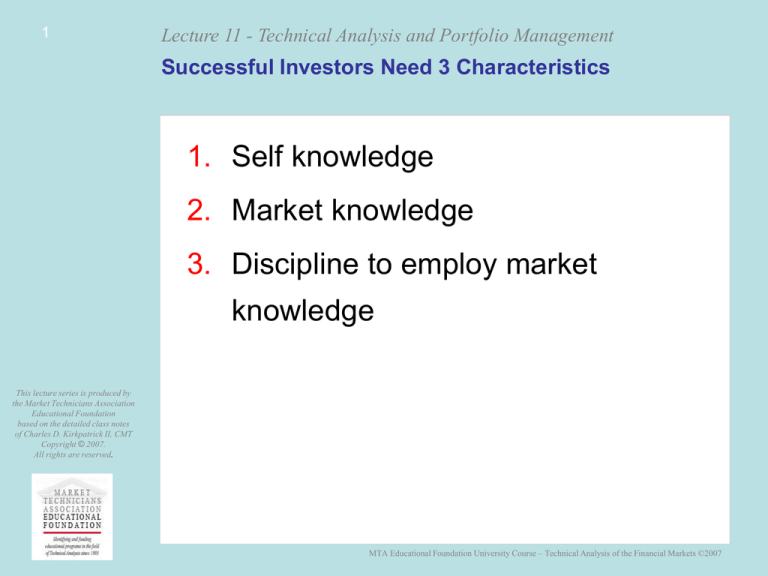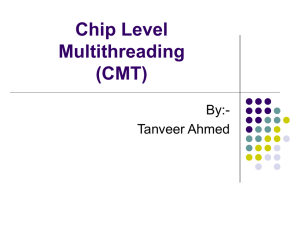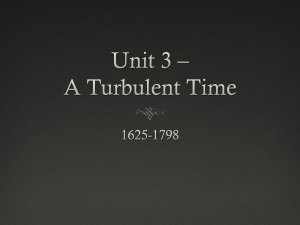
1
Lecture 11 - Technical Analysis and Portfolio Management
Successful Investors Need 3 Characteristics
1. Self knowledge
2. Market knowledge
3. Discipline to employ market
knowledge
This lecture series is produced by
the Market Technicians Association
Educational Foundation
based on the detailed class notes
of Charles D. Kirkpatrick II, CMT
Copyright © 2007.
All rights are reserved.
MTA Educational Foundation University Course – Technical Analysis of the Financial Markets ©2007
2
Lecture 11 - Technical Analysis and Portfolio Management
Portfolio Management
• Asset Allocation
– How much in stocks
• Security Selection
– What to buy
– When to buy
– When to sell
This lecture series is produced by
the Market Technicians Association
Educational Foundation
based on the detailed class notes
of Charles D. Kirkpatrick II, CMT
Copyright © 2007.
All rights are reserved.
• Technical analysis is critical to
answering “when?”
MTA Educational Foundation University Course – Technical Analysis of the Financial Markets ©2007
3
Lecture 11 - Technical Analysis and Portfolio Management
The Loser’s Game
Example: Tennis is actually two games
• At the amateur level, players lose
points
– The victor gets a higher score because the
other player makes more mistakes
• At the professional level, players win
points
This lecture series is produced by
the Market Technicians Association
Educational Foundation
based on the detailed class notes
of Charles D. Kirkpatrick II, CMT
Copyright © 2007.
All rights are reserved.
– Ultimate outcome is determined by the
actions of the winner
• Professional sports are a Winner’s
Game, amateurs play a Loser’s Game
MTA Educational Foundation University Course – Technical Analysis of the Financial Markets ©2007
4
Lecture 11 - Technical Analysis and Portfolio Management
Portfolio Management is a Loser’s Game
• Passive indexes, the benchmark (or
the other player in the game) have no
costs
– To win, investment managers must
overcome the cost disadvantage
• Winning requires making fewer
mistakes
This lecture series is produced by
the Market Technicians Association
Educational Foundation
based on the detailed class notes
of Charles D. Kirkpatrick II, CMT
Copyright © 2007.
All rights are reserved.
– Following defined sell disciplines prevents
holding stocks falling to zero
MTA Educational Foundation University Course – Technical Analysis of the Financial Markets ©2007
5
Lecture 11 - Technical Analysis and Portfolio Management
Investment Policy - Why It Matters
“Almost all of the really big trouble
that you’re going to experience in the
next year is in your portfolio right now;
if you could reduce some of these really
big problems, you might come out the
winner in the Loser’s Game.”
This lecture series is produced by
the Market Technicians Association
Educational Foundation
based on the detailed class notes
of Charles D. Kirkpatrick II, CMT
Copyright © 2007.
All rights are reserved.
- Charles D. Ellis
MTA Educational Foundation University Course – Technical Analysis of the Financial Markets ©2007
6
Lecture 11 - Technical Analysis and Portfolio Management
Beating the Market
• Market Timing
– Due to costs and risk of being out of the
market, investment managers need to be
right 75% of the time to break even
• Stock Selection
This lecture series is produced by
the Market Technicians Association
Educational Foundation
based on the detailed class notes
of Charles D. Kirkpatrick II, CMT
Copyright © 2007.
All rights are reserved.
– Efficient markets result from well-done
analysis
– Selecting tomorrow’s winners is a
challenging task
MTA Educational Foundation University Course – Technical Analysis of the Financial Markets ©2007
7
Lecture 11 - Technical Analysis and Portfolio Management
Beating the Market (continued)
• Portfolio Strategy
– Asset allocation or sector allocation can
define success; challenges are similar to
market timing
• Investment Philosophy
– Develop a well-defined set of principles
and strictly adhere to them
This lecture series is produced by
the Market Technicians Association
Educational Foundation
based on the detailed class notes
of Charles D. Kirkpatrick II, CMT
Copyright © 2007.
All rights are reserved.
MTA Educational Foundation University Course – Technical Analysis of the Financial Markets ©2007
8
Lecture 11 - Technical Analysis and Portfolio Management
Invest Like the Best
• James O’Shaughnessy studied great
investors and tested their ideas
• Successful portfolios had
characteristics different than the
overall market
This lecture series is produced by
the Market Technicians Association
Educational Foundation
based on the detailed class notes
of Charles D. Kirkpatrick II, CMT
Copyright © 2007.
All rights are reserved.
MTA Educational Foundation University Course – Technical Analysis of the Financial Markets ©2007
9
Lecture 11 - Technical Analysis and Portfolio Management
Investing Styles
• Growth
– Aggressive growth
– Established growth
– Momentum
• Value
This lecture series is produced by
the Market Technicians Association
Educational Foundation
based on the detailed class notes
of Charles D. Kirkpatrick II, CMT
Copyright © 2007.
All rights are reserved.
–
–
–
–
Low price-to-earnings
Low price-to-sales
Low price-to-book
High yield
80% of a portfolio's return is attributable to style
MTA Educational Foundation University Course – Technical Analysis of the Financial Markets ©2007
10
Lecture 11 - Technical Analysis and Portfolio Management
Timing
• Styles come into and out of favor
– 1999 growth outperformed value
– 2003 value outperformed growth
• The best long-term managers stick
with their style through various market
cycles
This lecture series is produced by
the Market Technicians Association
Educational Foundation
based on the detailed class notes
of Charles D. Kirkpatrick II, CMT
Copyright © 2007.
All rights are reserved.
MTA Educational Foundation University Course – Technical Analysis of the Financial Markets ©2007
11
Lecture 11 - Technical Analysis and Portfolio Management
Value Investing
• Combining value factors can be a
winning strategy
– For example, a low P/E by itself may lead
to purchasing stocks heading into
bankruptcy
• Best combination:
This lecture series is produced by
the Market Technicians Association
Educational Foundation
based on the detailed class notes
of Charles D. Kirkpatrick II, CMT
Copyright © 2007.
All rights are reserved.
–
–
–
–
–
Low price-to-sales ratio
Earnings persistency (EPS up 5 years in a row)
Low price-to-book ratio
ROE > 15%
High share price relative strength
MTA Educational Foundation University Course – Technical Analysis of the Financial Markets ©2007
12
Lecture 11 - Technical Analysis and Portfolio Management
Stock Market Winners
• Biggest stock market winners share
common characteristics:
–
–
–
–
Strong quarterly earnings acceleration
Identifiable group leadership
Important volume indicators
New leadership
This lecture series is produced by
the Market Technicians Association
Educational Foundation
based on the detailed class notes
of Charles D. Kirkpatrick II, CMT
Copyright © 2007.
All rights are reserved.
MTA Educational Foundation University Course – Technical Analysis of the Financial Markets ©2007
13
Lecture 11 - Technical Analysis and Portfolio Management
Stock Market Winners (continued)
• Also, note the percentage increase in
earnings per share was substantially
more crucial than the P/E ratio as a
cause of impressive stock performance
– Look at the P/E at the pivot “buy point” and
how as the advance continued, these
stocks expanded their P/E’s
This lecture series is produced by
the Market Technicians Association
Educational Foundation
based on the detailed class notes
of Charles D. Kirkpatrick II, CMT
Copyright © 2007.
All rights are reserved.
MTA Educational Foundation University Course – Technical Analysis of the Financial Markets ©2007
14
Lecture 11 - Technical Analysis and Portfolio Management
Growth Factors
This lecture series is produced by
the Market Technicians Association
Educational Foundation
based on the detailed class notes
of Charles D. Kirkpatrick II, CMT
Copyright © 2007.
All rights are reserved.
• Twelve-month EPS change higher than
average
• Last quarter EPS change higher than
average
• Estimated EPS change higher than
average
• Strong relative strength
MTA Educational Foundation University Course – Technical Analysis of the Financial Markets ©2007
15
Lecture 11 - Technical Analysis and Portfolio Management
C-A-N-S-L-I-M
• Popularized by William O’Neil
• Data readily available in Investor’s
Business Daily
• Combines growth and value
• Based upon a study of past market
winners
This lecture series is produced by
the Market Technicians Association
Educational Foundation
based on the detailed class notes
of Charles D. Kirkpatrick II, CMT
Copyright © 2007.
All rights are reserved.
MTA Educational Foundation University Course – Technical Analysis of the Financial Markets ©2007
16
Lecture 11 - Technical Analysis and Portfolio Management
C-A-N-S-L-I-M
This lecture series is produced by
the Market Technicians Association
Educational Foundation
based on the detailed class notes
of Charles D. Kirkpatrick II, CMT
Copyright © 2007.
All rights are reserved.
C = Current EPS growth – should be a
minimum of 20%
A = Annual EPS growth – should be at
least 15-20% for 3 years
N = New. The greatest winners had a
major new product, new management,
or new industry conditions
A new high in price can alert you to
new fundamental developments
MTA Educational Foundation University Course – Technical Analysis of the Financial Markets ©2007
17
Lecture 11 - Technical Analysis and Portfolio Management
C-A-N-S-L-I-M
This lecture series is produced by
the Market Technicians Association
Educational Foundation
based on the detailed class notes
of Charles D. Kirkpatrick II, CMT
Copyright © 2007.
All rights are reserved.
S = Shares outstanding – past winners
have had an average of less than 25
million
L = Leadership – demonstrated by high
relative strength for the stock and the
stock’s industry group
I = Institutional sponsorship – good
stocks are owned by institutions
M = Market – even good stocks go down
in a bear market
MTA Educational Foundation University Course – Technical Analysis of the Financial Markets ©2007
18
Lecture 11 - Technical Analysis and Portfolio Management
C-A-N-S-L-I-M: When to Buy
• Buy on a breakout to a new high
– Popularizes “cup and handle” formation
– Confirmed by at least a 50% increase in
volume
• Buy after the stock has formed a base
– Minimum 7 weeks consolidation works
best
This lecture series is produced by
the Market Technicians Association
Educational Foundation
based on the detailed class notes
of Charles D. Kirkpatrick II, CMT
Copyright © 2007.
All rights are reserved.
• Buy within 5-10% of the breakout point
• Use an 8% stop loss
MTA Educational Foundation University Course – Technical Analysis of the Financial Markets ©2007
19
Lecture 11 - Technical Analysis and Portfolio Management
The Buy Decision
• High relative strength
– Screens for stocks in the highest 10%
– Calculated as
(closing price/26-week moving average of price)
• High earnings per share growth rate
– Screens for stock in the highest 10%
– Calculated with quarters of the reported
data to minimize seasonal influences
This lecture series is produced by
the Market Technicians Association
Educational Foundation
based on the detailed class notes
of Charles D. Kirkpatrick II, CMT
Copyright © 2007.
All rights are reserved.
(most recent 4 quarters/first 4 quarters)
MTA Educational Foundation University Course – Technical Analysis of the Financial Markets ©2007
20
Lecture 11 - Technical Analysis and Portfolio Management
The Buy Decision (continued)
• Low price-to-sales ratio
– Screens for stocks in lowest 30%
– Calculated as:
(Price)/(Last 4 quarters of sales)
This lecture series is produced by
the Market Technicians Association
Educational Foundation
based on the detailed class notes
of Charles D. Kirkpatrick II, CMT
Copyright © 2007.
All rights are reserved.
MTA Educational Foundation University Course – Technical Analysis of the Financial Markets ©2007
21
Lecture 11 - Technical Analysis and Portfolio Management
The Sell Decision
• Hold until
– Relative strength declines below the 30th
percentile
or
– Earnings per share growth rate declines
below the 50th percentile
This lecture series is produced by
the Market Technicians Association
Educational Foundation
based on the detailed class notes
of Charles D. Kirkpatrick II, CMT
Copyright © 2007.
All rights are reserved.
MTA Educational Foundation University Course – Technical Analysis of the Financial Markets ©2007
22
Lecture 11 - Technical Analysis and Portfolio Management
The Results
This lecture series is produced by
the Market Technicians Association
Educational Foundation
based on the detailed class notes
of Charles D. Kirkpatrick II, CMT
Copyright © 2007.
All rights are reserved.
MTA Educational Foundation University Course – Technical Analysis of the Financial Markets ©2007
23
Lecture 11 - Technical Analysis and Portfolio Management
Conclusion
• Portfolio management requires buy
and sell rules
• Technical analysis adds value to this
process
This lecture series is produced by
the Market Technicians Association
Educational Foundation
based on the detailed class notes
of Charles D. Kirkpatrick II, CMT
Copyright © 2007.
All rights are reserved.
MTA Educational Foundation University Course – Technical Analysis of the Financial Markets ©2007
24
Lecture 11 - Technical Analysis and Portfolio Management
Putting It All Together
Stock Selection: A test of relative stock
values reported over 17-1/2 years*
– by Charles D. Kirkpatrick II, CMT
– 2001 Dow Award Winning Paper
– Provides results of real-time tracking of
two portfolio management models
– Portfolio usually holds 10-20 stocks
This lecture series is produced by
the Market Technicians Association
Educational Foundation
based on the detailed class notes
of Charles D. Kirkpatrick II, CMT
Copyright © 2007.
All rights are reserved.
*Paper available for download on
www.mtaeducationalfoundation.org/lecture
MTA Educational Foundation University Course – Technical Analysis of the Financial Markets ©2007












